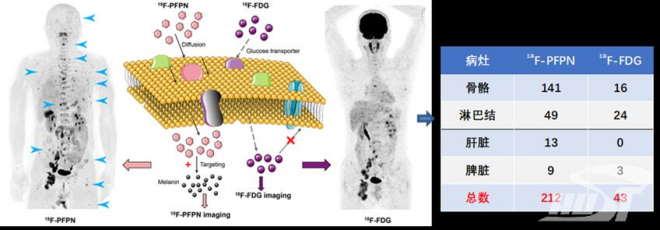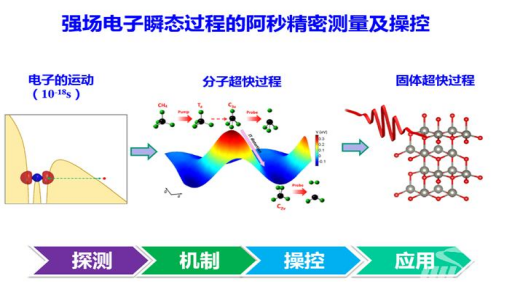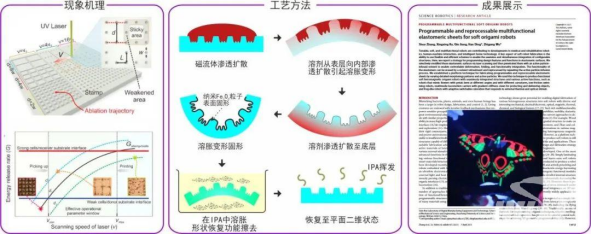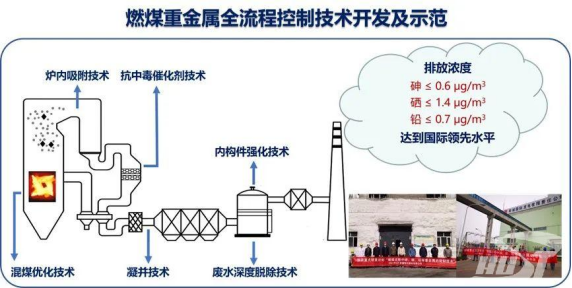2022 Academic Advances of HUST announced
The 2022 Academic Advances of HUST has recently been announced. Ten advances have been selected, demonstrating HUSTers’ ambition to make innovation and the spirit to excel, to perfect, to strive, and to persist.
A brief overview of the ten advances
1. The development and clinical transformation of the 18F-PFPN PET probe
Mainly completed by: Lan Xiaoli, Zhang Xiao, Gai Yongkang

The 18F-PFPN PET imaging stage of patients with malignant melanoma, in which the number of detected lesions is far more than that of regular 18F-FDG imaging. (212 vs. 43; The lesions that 18F-FDG missed are indicated by the blue arrows.)
Malignant melanoma is a form of malignant tumor caused by melanocytes, with yearly-increasing incidence and stubbornly high mortality. Making an accurate diagnosis in the earliest stages is crucial for prognosis. This team autonomously developed the melanin-targeted PET probe18F-PFPN with independent intellectual property. Through PET probe imaging, the initial growths and metastases of small melanoma can be found in the early stage. Moreover, the ability to detect inflammatory lesions becomes feasible via PET probe significantly improves the accuracy of diagnosis and the identification of stages of melanomas, providing a precise basis for clinical decision-making and benefiting the patients.
2. Attosecond precision measurement of strong-field quantum transient processes
Mainly completed by: Lan Pengfei, Li Min, Li Liang

Attosecond precision measurement can help with revealing the electron motion in matter. With this measurement, people gain a better understanding of the laws of physics in the micro process from a more basic level for a more precise and effective manipulation of microworlds. The Ultrafast optics team upgraded the Attosecond-Yahe ultra-high spatial resolution measurement method and measured tunneling position, bringing the precision up to the highest currently, the Pimmeter scale. This scientific advance lays a physical foundation for the revolution of Ultra-high speed information processing techniques.
3. 2D materials–based homogeneous transistor-memory architecture for neuromorphic hardware
Mainly completed by: Ye Lei, Miao Xiangshui team

The theory and structure of homogeneous transistor-memory architecture
To achieve intelligence comparable to the brain has long been a dream for humankind. Brain-like neuromorphic hardware is the cornerstone for brain-like intelligence. The research team has overcome the performance bottleneck in the communication between information sensing, storing, and computing. Its accomplishment paves the path for future disruptive brain-like intelligence and has been included in the list of the “2021 Top Ten Semiconductor Research Advances in China”.
4. Pharmacological research on complex integration signal of G-protein coupled receptor
Mainly completed by: Liu Jianfeng, Xu Chanjuan, Meng Jiyong, Liu Lei

G-protein coupled receptor forms new targets, regulating methods and new pathways via integrating signals in different complexes forms
The G-protein coupled receptor (GPCR) is an important drug target. Liu Jianfeng's team carried out research on new signal integration mechanisms with GPCR as the unit. The team overcame the technical barrier to researching endogenous GPCR complexes and proposed a new strategy for drug development.
5. The design and production of structure-programmable and function-reconfigurable soft robots
Mainly completed by: Wu Zhigang, Zhang Shuo, Ding Han

Exploration and application of integrative design and production of soft robots
Soft robots have vital importance and practical value for the realization of human-machine-loop co-integration. Targeted at the lack of effective coordination in structure and function designing and manufacturing of soft robot research, the team has proposed a series of design guidelines on two-to-three-dimension spatial structure and put forward manufacturing methods from different operable perspectives. By organically combining structure, function designing with producing, the team opened up a new course for integrative design and production of soft robots.
6. Autonomous Cross-domain Collaboration of USV-UAV Swarm System: theory, technology and application
Mainly completed by: Zhang Haitao, Zhao Jin, Su Housheng, Liu Xueming, Cao Zhiguo

High efficiency, ultra-stability and high precision are the essences of Unmanned Surface Vehicle (USV) swarm technology. The project overcame the technical constraint of USV swarm mutation in response to emergencies. It was also marked by the innovation of some key technologies, the development of cooperative control measures, and USV-UAV equipment. It has already been used in the South China Sea for resource exploration, with a cumulative measured length reaching 1400 km. Also, the operational efficiency has significantly been improved when it was applied to the cross-sea channel, offshore wind farms, and other major marine engineering monitor projects.
7. Heavy metal control technology in coal combustion
Mainly completed by: Yao Hong, Luo Guangqian, Hu Hongyun

Coal combustion is a major contributor to heavy metal pollution in China and the complex morphological changes of heavy metals in coal-fired power plants make it difficult for synergistic control. Supported by the National Key R&D Program, the research has made low-cost and high-efficiency control of heavy metals in coal combustion possible. Several related technologies have been successfully applied to over 20 coal-fired units.
8. Short-wave Infrared Imaging Chips for Quantum Dots
Mainly completed by: Tang Jiang, Gao Liang, Liu Jing

Humans receive more than 80% of their information by vision. Thus optical sensing chips are referred the “gate” to information in the era of the Internet of Things. Due to technological constraints, short-wave infrared chips were extremely costly, making large-scale applications difficult. The team has developed a low cost short-wave infrared detection chip with excellent imaging performance, which can be used for a variety of consumer-level applications.
9. Study on multi-organ pathology and molecular pathological mechanism for patients with terminal COVID pneumonia
Mainly completed by: Nie Xiu, Hu Yu, Xia Jiahong

Early on in the COVID-19 outbreak, the treatment confronted a dire situation as there were many patients in severe conditions and the mortality rate was high. The team of Wuhan Union Hospital carried out the clinicopathological analysis of minimally invasive organ autopsies and published their research results in top journals at home and abroad. The research is the first of its kind to reveal the panorama of protein changes in patients with terminal COVID pneumonia and its molecular pathological mechanism.
10. Van der Waals integration of two-dimensional optoelectronic devices
Mainly completed by: Zhai Tianyou, Zhou Xing, Liu Kailang

It is difficult to continue Moore's Law with conventional semiconductors. Two-dimensional semiconductors have many advantages and are expected to continue Moore's law. The team has developed an integrated photodetector for sensing and computing, which broke through the bottleneck of traditional image recognition and pushed forward its development. It also developed the first two-dimensional inorganic molecular crystal dielectric film, which promoted the progress of the scalable integration of two-dimensional semiconductor optoelectronic devices.
Written by: Yang Kunjie & Yu Shiyun
Edited by: Meng Ziyun, Ye Jingyi, Peng Yumeng
